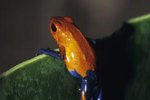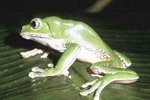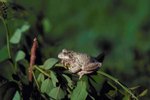
Dubbed the "Sparkling City by the Sea," the city of Corpus Christi borders the Gulf of Mexico along the southern coast of Texas. Perfectly suited for amphibian life, it has a humid, subtropical climate; the summers are long and steamy, and the winters are almost non-existent. Texas is inhabited by dozens of species of frogs, many of which call Corpus Christi home.
Rio Grande Chirping Frog
Rio Grande chirping frogs (Eleutherodactylus cystignathoides) have flat, elongated bodies colored brown, gray or yellow-green with dark spots. They have pointed snouts and prominent toe pads, and they grow to a diminutive 1/2- to 1-inch long. Nocturnal, they are rarely seen and hard to catch. These little amphibians can run as fast as they hop. They vocalize with cricket-like chirps, particularly when it rains.
Northern Cricket Frog
Diurnal northern cricket frogs (Acris crepitans) are often observed basking in the sun near shallow pools, creeks or ponds. They're dark green or brown, possess rounded snouts and are distinguished by a backward-pointing triangle on their heads. With their short, powerful legs and elongated hind feet, they're able to leap distances of 6 feet and are superb swimmers. Northern cricket frogs communicate with a series of clicks.
Green Treefrog
Green treefrogs (Hyla cinerea) inhabit densely vegetated areas near water. Their smooth, slim bodies are colored bright green and accented with white or yellow stripes along their jawlines and hind legs. They have white lips and large finger and toe pads. These social little frogs with voices like cow bells typically live in communal groups with up to 700 members. They tend to walk instead of jump, breaking into swift leaps only when pursued by predators.
Squirrel Treefrog
The smallest treefrogs in Texas, squirrel treefrogs (Hyla squirella) inhabit water-adjacent forests and woodlands. They're typically colored in shades of green with yellow flecks but, similar to the chameleon, can change colors and patterns to blend into their habitat. Aggressive, nocturnal foragers, they emerge at night to hunt for insects. They signal a coming rainfall with grunting quacks and emit a nasal trill as a mating call.
Spotted Chorus Frog
Spotted chorus frogs (Pseudacris clarkii) are gray- or olive-colored with bright green spots outlined in black. They possess small, round toe pads and a distinct green triangle between their eyes. They communicate with rough, raspy trills. They inhabit moisture-rich grasslands and prairies and are inactive during dry weather, taking refuge in underground burrows.
Sheep Frog
Named for their "bleating sheep" vocalizations, sheep frogs (Hypopachus variolosus) are chunky, round frogs with pointed snouts. They're generally dark brown or green with a yellow line down the centers of their backs. Nocturnal and secretive, they spend most of their time hiding under logs and leaf litter and in underground burrows near swamps and marshes, often burrowing into rodents' nests. Sheep frogs are a threatened species in Texas and are protected by the state.
Rio Grande Leopard Frog
Pale green or brown with dark spots, Rio Grande leopard frogs (Rana berlandieri) are moderately sized, reaching up to 4 inches in length. They inhabit arid areas near rivers, creeks and brooks, feasting on insects and just about anything they can fit in their mouths. Nocturnal in nature, they burrow into the cool, moist soil to avoid the heat of the day.
American Bullfrog
American bullfrogs (Rana catesbeiana) are the largest frogs in North America, growing up to 8 inches long. They're greenish-yellow with dark mottling and prominent external eardrums. Their deep, echoing vocalizations can be heard up to a quarter-mile away. They inhabit swamps, lakes and ponds, feasting on insects, crayfish, small frogs, small birds and snakes.
Honorable Mention: Toads
Frogs and toads are classified under the amphibian order Anura. While similar, there are a few key differences. Frogs typically possess long legs and smooth, mucus-coated skin, while toads have shorter legs and rougher, thicker skin. Frogs lay their eggs in clusters, while toads lay their eggs in strands. That being said, a number of toads make their homes in Corpus Christi and deserve mention. Common toads inhabiting the south Texas community are the Gulf coast toad, Texas toad, Woodhouse's toad, Great Plains narrow-mouthed toad, Couch's spadefoot and Hurter's spadefoot.
References
Resources
Photo Credits
-
Jupiterimages/Photos.com/Getty Images
Writer Bio
Yvette Sajem has been a professional writer since 1995. Her work includes greeting cards and two children's books. A lifelong animal advocate, she is active in animal rescue and transport, and is particularly partial to senior and special needs animals.



